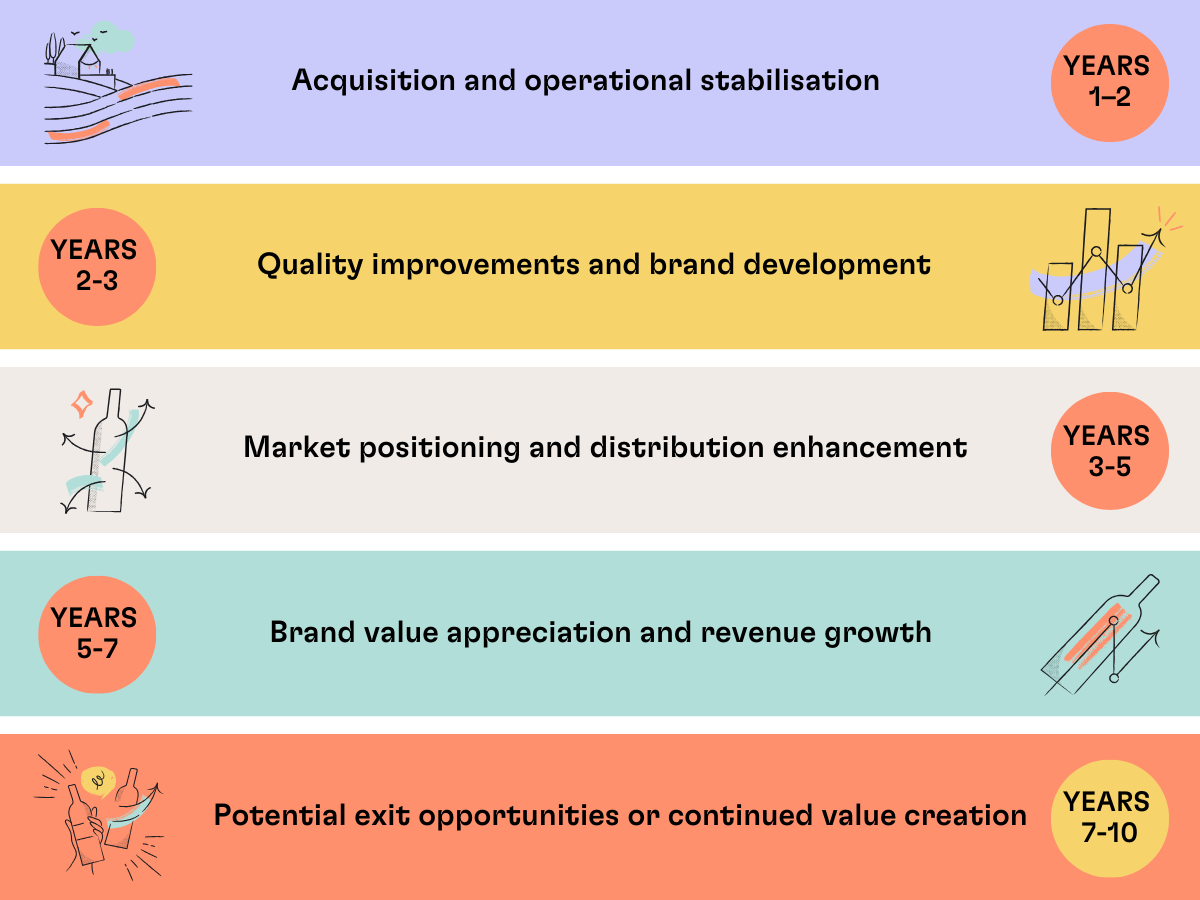
How to Invest in a Winery: A Guide to Winery Investment Opportunities
Investing in wineries is an alluring prospect for individuals who are not only passionate about fine wine but also intrigued by the potential for financial returns. Winery investment is a unique blend of business and lifestyle, offering the opportunity to own or be part of an enterprise that crafts one of the world’s most celebrated luxuries. However, investing in wineries differs significantly from investing in wine as an asset class.
The global wine market was valued at approximately $1,709.27 billion in 2023 and is projected to grow at a CAGR of 5.7% through 2033, according to the Wine Market Outlook from Future Market Insights. Winery investments often deliver returns through multiple revenue streams, including direct wine sales, land appreciation, and brand equity, providing a compelling comparison to wine as a tradable asset.
In this guide, we explore how to invest in a winery, highlighting prominent examples from Bordeaux, Champagne, the USA, and other noteworthy regions, while examining the potential returns. We also highlight the pros and cons of winery investment compared to wine investment, helping you decide which path might align with your goals. Finally, we discuss emerging trends, practical considerations, and alternative investment structures to provide a comprehensive overview.
Case Studies: Prominent Winery Investments
Risk Assessment in Winery Investment
Emerging Trends in Winery Investment
What is Winery Investment?
Definition of Winery Investment
Winery investment involves acquiring equity or a financial stake in a wine-producing business. This can take many forms, including outright ownership of vineyards, partnership arrangements, shares in larger wine conglomerates, or funding through private equity or crowdfunding platforms.
Why Invest in Wineries?
The motivations behind investing in wineries vary, often blending financial aspirations with personal passion. For some, it’s about diversifying their investment portfolio with a tangible asset that can appreciate over time. For others, it’s about the prestige and legacy associated with owning a piece of the wine industry. Additionally, many are drawn to the experiential aspect—the chance to be directly involved in producing a luxury good.
Revenue Stream Breakdown
Winery revenues are typically derived from the following:
- Direct Wine Sales: 40-60% of revenue
- Distribution Partnerships: 25-35%
- Wine Tourism and Events: 10-20%
- Land Appreciation: 3-7% annual growth in prime regions
Types of Winery Investors
Private individuals, often high-net-worth individuals, view winery ownership as a status symbol and a long-term investment. Corporate entities, especially luxury brand conglomerates, consider wineries valuable additions to their portfolios. Meanwhile, investment funds, including private equity groups focused on agriculture or luxury assets, target wineries for their growth potential.
Investment Entry Points
- Corporate Entities: £10–£50 million
- Private Individuals: £500,000–£5 million
- Winery Investment Funds: £100,000–£250,000
- Crowdfunding Platforms: Starting from £1,000
How to Invest in a Winery
Key Steps to Investing in Wineries
Investing in wineries requires careful planning and analysis. Conducting thorough research and due diligence is essential. This involves assessing a winery’s financial health, production capacity, and market positioning while also studying trends in the region where the winery operates. Once the groundwork is laid, prospective investors need to explore different investment models, including direct ownership, partnerships, or acquiring shares in corporations. Metrics like vineyard size, yield per hectare, revenue per bottle, and the winery’s historical performance must also be scrutinised.
Direct purchases of wineries or vineyards offer full control but require significant capital. Alternatively, joint ventures allow investors to share responsibilities with existing owners. Acquiring shares in larger wine companies can provide indirect exposure to winery profits, while private equity funds focused on wineries allow for more diversified investment.
Operational Metrics
Production Metrics:
- Yield Efficiency: 3,000–8,000 litres per hectare (e.g., regions like Napa average 6,000 litres per hectare, ensuring high profitability with premium pricing).
- Production Costs: £2.50–£15 per bottle (with Burgundy’s top producers closer to the higher end due to meticulous manual processes).
- Operating Margins: 15–45% for premium producers achieve higher margins through direct-to-consumer channels.
- Revenue Per Hectare: £15,000–£150,000 (Central Otago Pinot Noir vineyards regularly achieve the upper limit due to global demand).
Operating Costs:
- Vineyard Maintenance: £8,000–£25,000 per hectare annually (South African vineyards at the lower range; Bordeaux Grand Cru Classé estates at the upper end).
- Equipment/Facility Maintenance: 5–15% of revenue (large-scale producers invest heavily in automation to reduce these costs).
- Labour Costs: 25–40% of operating expenses (notably high in regions like Burgundy due to skilled labour demands).
- Marketing and Distribution: 15–30% of revenue (e.g., Napa wineries relying on experiential marketing often exceed 25%).
Global Market Context
The global wine industry produces approximately 260 million hectolitres annually (2023), with Europe accounting for 60% of total production. Major producers like Italy, France, and Spain dominate exports while emerging markets in China and the USA fuel consumption growth. Import/export dynamics and shifting consumer trends, such as the preference for organic and sustainable wines, significantly impact winery valuations.
Case Studies: Prominent Winery Investments
Investing in Bordeaux Wineries
Bordeaux’s reputation as the epicentre of premium wine has attracted high-profile investors. Bernard Arnault, CEO of LVMH, acquired Château Cheval Blanc, a move that underscored his dedication to enhancing the estate’s global branding and modernising its production facilities. François Pinault’s acquisition of Château Latour in 1993 for a reported £86 million (The Times) marked a new chapter for the historic estate, focusing on sustainability and elevating its global reputation.
Prime vineyard land in Bordeaux is among the most expensive globally, costing between £300,000 and £2 million per hectare, depending on the appellation.
Investing in Champagne Wineries
Investors seeking alignment with luxury and celebration have long leveraged Champagne's enduring appeal. LVMH, through its ownership of Dom Pérignon, Veuve Clicquot, and Moët & Chandon, dominates the market by coupling heritage with high-end marketing strategies. Prime Champagne vineyards cost upwards of £1.5 million per hectare, reflecting the region’s prestige and limited land availability.
A notable case study is the acquisition of Champagne Telmont by Rémy Cointreau in 2020. This investment emphasised sustainability, with Telmont aiming to become entirely organic by 2025. The acquisition allowed Rémy Cointreau to expand its portfolio with a brand that aligns with modern consumer preferences for environmentally friendly practices. Since the acquisition, Telmont has seen increased international distribution and brand visibility, showcasing how strategic ownership can align heritage with market demands.
Bollinger, a family-owned Champagne house, provides an alternative narrative, maintaining independence while strategically growing its artisanal identity. Investments in Champagne have proven lucrative, with global demand for premium sparkling wines steadily increasing.
Winery Investment in the USA
The USA, particularly Napa Valley, represents a thriving wine investment market. Constellation Brands’ acquisition of Robert Mondavi Winery expanded the brand’s global reach and positioned it among the leaders of premium wine production. E&J Gallo’s continued investments in high-end labels and wine tourism have solidified Napa Valley’s reputation as a top-tier destination for consumers and investors. Depending on location and prestige, Napa vineyard land prices range from $150,000 to $500,000 (£120,000 to £400,000) per hectare.
Exploring Italian Wineries
Italy’s iconic regions, such as Tuscany and Piedmont, host world-renowned wineries like Tenuta San Guido, producer of Sassicaia, and Marchesi Antinori. These wineries attract investors with their combination of heritage, strong branding, and consistently high-quality wines. Investments in these wineries have not only preserved historical estates but also enhanced their international market presence. For instance, Sassicaia’s vintages regularly achieve top scores, boosting secondary market values significantly.
Opportunities in Spanish Wineries
Spanish wineries offer compelling opportunities, particularly in Rioja and Ribera del Duero. Vega Sicilia, one of Spain’s most prestigious wineries, stands out for its limited production and consistently high demand. Similarly, Marqués de Murrieta’s blend of tradition and innovation has made it a top choice for collectors and investors. These wineries have seen steady growth in export markets, with their flagship wines commanding premium prices globally.
South American Investments
Chile and Argentina are emerging regions with high potential. Wineries like Catena Zapata in Argentina have elevated the reputation of Malbec, while Concha y Toro in Chile has become a global name for quality and scalability. Investors are drawn by lower land costs and strong export growth. For example, Catena Zapata’s Adrianna Vineyard wines have received critical acclaim, rivalling some Bordeaux estates in prestige and price appreciation.
South African Wineries
South Africa’s Stellenbosch and Franschhoek regions are gaining recognition for producing premium wines at competitive prices. Estates like Kanonkop and Meerlust have successfully positioned themselves as top-tier producers, appealing to traditional wine lovers and modern connoisseurs. Investments in South African wineries often focus on their unique terroir and increasing appeal in global markets.
New Zealand’s Niche Opportunities
Known for Sauvignon Blanc and Pinot Noir, New Zealand’s wineries like Cloudy Bay and boutique producers in Central Otago are attracting attention. Cloudy Bay’s acquisition by LVMH illustrates how strategic investments can elevate a brand’s global profile. Pinot Noir from Central Otago has seen growing demand in high-end markets.
China’s Emerging Wine Industry
China’s domestic wine market is rapidly expanding, with regions like Ningxia producing high-quality wines that have gained international acclaim. Wineries such as Chateau Changyu and Helan Qingxue are setting benchmarks for Chinese wine, attracting both local and international investment. The growth of China’s middle class and their increasing interest in premium wines make this an exciting frontier for winery investments.
Risk Assessment in Winery Investment
Climate Impact
- Annual Yield Variation: 5–15%
- Insurance Costs: 1–3% of asset value
- Irrigation System Investments: £5,000–£15,000 per hectare
Financial Risks
- Market Price Volatility: 10–30% annual variation
- Energy Cost Impact: 8–12% of production expenses
- Labour Cost Inflation: 5–7% annually
- Regulatory Compliance: 3–5% of revenue
Emerging Trends in Winery Investment
E-commerce Growth
Direct-to-consumer sales via e-commerce platforms have grown exponentially, offering wineries improved profit margins and stronger customer relationships.
Sustainable Practices
Wineries adopting sustainable practices are seeing increased valuations. From solar-powered facilities to organic certification, environmentally conscious operations attract both consumers and investors.
Technology Investment
Investments in precision agriculture and automated technologies provide measurable ROI by reducing costs and improving yield quality.
Practical Considerations
Understanding Terroir
Terroir—the combination of soil, climate, and geography—plays a pivotal role in wine quality. Prime terroirs in regions like Champagne and Burgundy command premium prices due to their ability to produce consistently high-quality vintages. Investors should evaluate terroir characteristics when assessing winery potential.
Investment Timeline

Pros and Cons of Winery Investment
Pros
- Diversification: Investing in wineries provides a tangible asset that adds diversity to a portfolio, often unaffected by traditional stock market fluctuations.
- Revenue Streams: Wineries generate income through multiple channels, including wine sales, events, tourism, and land appreciation.
- Prestige and Legacy: Ownership of a winery offers not just financial returns but also personal satisfaction and status.
- Land Appreciation: Prime wine regions consistently see land value increases, offering potential long-term gains.
- Emerging Market Opportunities: South America and China regions have high growth potential with relatively low initial investments.
Cons
- High Initial Capital: Entry costs can be prohibitively high, especially for established wineries in premium regions.
- Operational Complexity: Running a winery requires expertise in viticulture, marketing, and business operations, often necessitating additional hiring or partnerships.
- Climate Risks: Weather variability and climate change pose significant threats to crop yields and quality.
- Market Volatility: Fluctuating wine prices and consumer trends can affect profitability.
- Illiquidity: Wineries are long-term investments, often requiring years before yielding significant returns.
Comparing Winery and Wine Investment Opportunities
Investing in wineries is a rewarding venture for those with the vision and patience to navigate its complexities. Whether driven by passion, profit, or a blend of both, winery investment offers a unique opportunity to be part of a dynamic and storied industry. However, it is important to understand how it compares to traditional wine investment, as both approaches appeal to different types of investors with distinct goals.
Similarities Between Winery and Wine Investment
Both winery investment and wine investment offer the allure of diversification, providing tangible assets that often retain value during times of economic uncertainty. Each can provide lucrative financial returns and align well with investors seeking exposure to the luxury goods market. Additionally, both markets allow investors to leverage the global demand for fine wine—whether that demand comes from direct consumers, distributors, or collectors.
Key Differences
While wine investment focuses on acquiring and trading bottles or cases of wine, winery investment involves acquiring equity or ownership in the production process itself. Wine investment is generally more liquid; investors can sell individual bottles or portfolios with relative ease through auctions, platforms, or brokers. In contrast, winery investments are typically long-term, requiring greater involvement, capital, and patience.
Operational complexity also sets winery investment apart. Running a winery entails managing vineyards, overseeing production processes, marketing, and navigating changing consumer trends. Wine investment, on the other hand, relies on understanding market prices, vintages, and critic scores to identify bottles that can increase in value.
Choosing the Right Path
For investors seeking a hands-on experience and the prestige of contributing to the creation of a luxury product, winery investment can be deeply rewarding. Fine wine investment may be the better choice for those looking for a more flexible, liquid, and data-driven investment. Both avenues can coexist in a diversified portfolio, offering complementary benefits.
If you’re curious about the potential of investing in wine, whether as an alternative to or alongside winery ownership, download our Fine Wine Investment Guide.
Learn how fine wine can deliver attractive returns and seamlessly enhance your investment strategy while avoiding the operational challenges of winery ownership.

Fine Wine Investment Guide 2025
Download your guide to fine wine investing and discover how this unique, tangible, and tax-efficient asset can enhance portfolio diversification. Gain valuable knowledge and insights with this indispensable document for investors.
The prices provided on our website are estimates based on publicly available data and represent the most recent figures available as of December 2024. While we strive for accuracy, prices may change due to market conditions, availability, or currency exchange rates.
We encourage you to perform your own due diligence if using these figures for investment projections or financial planning. Please note that these estimates are for informational purposes only and should not be considered definitive or binding.



